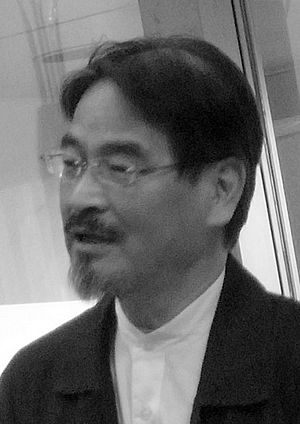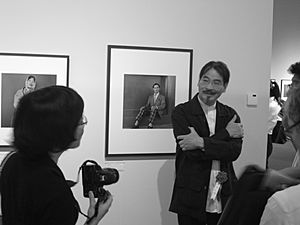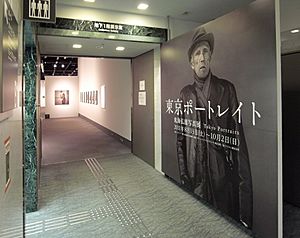Hiroh Kikai facts for kids
Hiroh Kikai (鬼海 弘雄, Kikai Hiroo, 18 March 1945 – 19 October 2020) was a famous Japanese photographer. He was known for his amazing black-and-white photos. He took pictures of buildings in Tokyo, people in the Asakusa area of Tokyo, and everyday life in India and Turkey. He worked on these photo projects for over twenty years. Each project led to popular photo books.
Kikai became widely known in 2004. His book Persona, which showed portraits from Asakusa, won two major awards: the Domon Ken Award and the Annual Award from the PSJ. Later, in 2009, his book Asakusa Portraits was published for people around the world.
Contents
Early Life and Start in Photography
Hiroh Kikai was born on March 18, 1945, in a village called Daigo in Yamagata Prefecture, Japan. He was the youngest of seven children. He had a happy childhood and loved playing outdoors by himself.
After high school, he worked for a year in Yamagata. Then, he moved to Tokyo to study philosophy at Hosei University. As a student, he loved movies, especially films by Andrzej Wajda and Satyajit Ray. He even thought about working in film, but he didn't like writing scripts and didn't have enough money.
After graduating in 1968, Kikai worked as a truck driver and in a shipyard. His philosophy professor, Sadayoshi Fukuda, introduced him to the editor of a photography magazine. There, Kikai saw photos by Diane Arbus that really inspired him. He started taking his own photos in 1969. His professor even lent him money to buy a special camera called a Hasselblad 500CM. This was the camera Kikai used for many of his famous portraits.
Photography Career
Kikai wanted to take photos on a boat, but he had no experience. He finally got a job on a tuna fishing boat in 1972. He sailed in the Pacific Ocean and stopped in Manzanillo, Colima, Mexico. During this trip, he took his first photos that were published in a magazine.
In 1973, he won an award for his photos. Kikai realized he needed to learn how to develop photos himself. So, he worked at a photo lab from 1973 to 1976. He became a photographer who worked for himself in 1984.
Kikai lived near Asakusa in Tokyo. He often visited the area on his days off to take pictures of people. He started visiting more often in 1985. Many of his famous portrait collections come from his time in Asakusa.
His other long-term photo projects included pictures of neighborhoods in Tokyo. He also photographed people and scenes in India and Turkey. All these photos were in black and white. Kikai also took some color photos, like those of the Gotō Islands.
Unlike many photographers in Japan, Kikai preferred to work alone. He didn't join any photography groups. He also didn't carry a camera with him all the time. He let his wife, Noriko, take photos of their family.
Kikai taught photography at Musashino Art University for a while. However, he stopped because he felt students didn't try hard enough.
Hiroh Kikai passed away on October 19, 2020, from lymphoma, a type of cancer.
Asakusa Portraits
Kikai began his famous Asakusa series of square, black-and-white portraits in 1973. He took a break from this project until 1985. Then, he discovered that the plain red walls of Sensō-ji temple made a perfect background. For most of these portraits, the person stood directly in front of his camera. They looked straight at him and were shown from their knees up.
Kikai would sometimes wait for hours at the temple to find someone interesting to photograph. Some days he wouldn't take any pictures, but other days he might photograph three people. He photographed over 600 people this way. He believed that a simple background helped viewers see the person clearly, without distractions.
Kikai started photographing in Asakusa because it was close to his home. He continued because he loved the area and the unique people who visited it. Asakusa used to be a very busy and fashionable place. But it lost some of that fame over time. Kikai said he wouldn't photograph there if it were still as crowded as it used to be.
His first collection of these portraits, Ōtachi no shōzō / Ecce Homo, was published in 1987. It featured photos taken in 1985 and 1986. Kikai won the 1988 Newcomer's Award for this book. He also won the third Ina Nobuo Award for the exhibition that went with it.
In 1995, some of his portraits were shown at the Tokyo Metropolitan Museum of Photography. Another collection, Ya-Chimata, came out a year later.
Persona (2003) is another collection of Asakusa portraits. Some photos were from his early work, but most were newer. Several people appeared more than once in the book, showing how time had changed them. This book won the 23rd Domon Ken Award and the 2004 Annual Award. A smaller version with more photos was released two years later.
Asakusa Portraits (2008) was a large collection put together by the International Center of Photography (New York). It was published with an exhibition of Japanese photography called Heavy Light. Kikai's photos in this exhibition were very popular.
Portraits of Spaces
Kikai believed that people and places were connected. When he got tired of waiting in Asakusa, he would walk up to 20 kilometers looking for interesting city scenes. He called these "portraits of spaces." He usually took photos between 10 a.m. and 3 p.m. He avoided photographing when people were around, as he felt their presence made the photos too simple. Even without people, his photos showed signs of life. Sometimes, he would wait for something unexpected to happen in the scene before taking a picture.
Examples from this series appeared in magazines starting in 1976. Each photo simply had a caption with the address and year.
Tōkyō meiro / Tokyo Labyrinth (1999) showed photos of empty spaces in Tokyo and nearby Kawasaki, Kanagawa. These included shop fronts, rows of shops, and quiet streets. Most of the buildings were ordinary. Like his Asakusa series, these photos were black and white and square.
Tōkyō mutan / Labyrinthos (2007) featured more of these "portraits of spaces." This book also included Kikai's essays about the people of Tokyo, based on his walks and train rides.
Tokyo View (2016) was a large book. Most of its photos had appeared in his earlier books.
India Photos
Kikai said that visiting India felt like going back to his childhood in Yamagata Prefecture. It helped him feel free from life in Tokyo. His photos in India were less planned than his Tokyo portraits. He used black-and-white 35mm film there. He joked that he would use 35mm film in Tokyo if the city were more interesting.
His large book India, published in 1992, showed photos taken in India (and a little in Bangladesh) between 1982 and 1990. The book received high praise. It won Kikai the 1993 Society of Photography Award.
Shiawase / Shanti (2001) was a collection of photos focusing on children. Most of these were taken in cities like Allahabad, Benares, Calcutta, Puri, and Delhi in 2000. It won the Grand Prix at the second Photo City Sagamihara Festival.
Turkey Photos
Kikai wanted to explore a cold place that was also a Muslim country where Asian and European cultures met. So, in 1994, he made his first trip to Turkey. He visited Turkey six times in total, staying for nine months. His black-and-white photos of Turkey appeared in the magazine Asahi Camera. His large book Anatolia, published in 2011, collected his black-and-white work from Turkey.
Other Photography Projects
Kikai was one of thirteen Japanese photographers asked to photograph the twenty-six nations of the European Union. He spent time in Malta in 2005 and Portugal in 2004. These photos were in color, which was different from his usual work. Most of them were natural photos of people. This collection was published in a book called In-between 8.
He also took color photos during short visits to Cuba (2007) and Taiwan (2013). These appeared in Asahi Camera magazine.
Writing
Kikai also wrote essays. They appeared in magazines and some of his own photo books. These essays were collected in four books, with photos to go with them.
Indo ya Gassan ("India and Gassan", 1999) was a collection of essays and photos about India. Gassan is a mountain near where Kikai grew up. In this book, he thought about India and compared it to his childhood in Yamagata.
Other essay collections include Me to kaze no kioku ("Memories of the eye and the wind", 2012), Dare omo sukoshi suki ni naru hi: Memekuri bōbiroku ("Days when you come to like anyone a little: An image-turning aide-memoire", 2015), and Kutsuzoku no herikata ("Ways to wear down shoe rubber", 2016).
Exhibitions
Hiroh Kikai's work was shown in many exhibitions around the world. Here are some examples:
- [A]: Asakusa portraits
- [I]: India
- [S]: Portraits of spaces
- [T]: Turkey
Selected Solo Exhibitions
- "Nagi: Machinaka no kōkei" (Calm: Town scenes). [S] Konica Minolta Plaza (Shinjuku, Tokyo), 1983.
- "Indo kikō" (India travelogue). [I] Doi Photo Plaza Shibuya (Shibuya, Tokyo), 1984.
- "Ōtachi no shōzō (Sensōji keidai)" (Portraits of kings [in the grounds of Sensō-ji]). [A] Ginza Nikon Salon (Ginza, Tokyo), 1988.
- "Persona". [A] Domon Ken Photography Museum (Sakata), 2004.
- "Tōkyō mutan" (Tokyo dreams). [S] Ginza Nikon Salon (Ginza, Tokyo), 2007.
- "Tokyo Labyrinth". [S] Yancey Richardson Gallery (New York City), 2008.
- "Tōkyō pōtoreito" (Tokyo portraits). [A, S] Tokyo Metropolitan Museum of Photography (Ebisu, Tokyo), 2011.
- "Anatoria" (Anatolia). [T] M2 (Shinjuku, Tokyo), 2011.
- "Persona". [A, S, I, T] Yamagata Museum of Art (Yamagata), 2011–2012.
- "India 1982–2011". [I] Canon Gallery S (Shinagawa, Tokyo), 2014.
- "Persona: The Final Chapter". [A] Irie Taikichi Memorial Museum of Photography Nara City, 2019.
Selected Group Exhibitions
- "Tokyo/City of Photos". [A] Tokyo Metropolitan Museum of Photography, 1995. Kikai's work was shown with eleven other photographers.
- "Heavy Light: Recent Photography and Video from Japan". [A] International Center of Photography (New York), 2008.
- "With Different Eyes: The Portrait in Contemporary Photography." [A] Die Photografische Sammlung/SK Stiftung Kultur, Cologne, 2016.
Permanent Collections
Kikai's photographs are kept in the permanent collections of several museums:
- Tokyo Metropolitan Museum of Photography
- Museum of Modern Art, Toyama (Japan)
- Domon Ken Photography Museum (Sakata, Yamagata, Japan)
- Neue Nationalgalerie (Berlin)
- Walther Collection (Neu-Ulm, Germany / New York)
- Center for Creative Photography (University of Arizona, Tucson)
- Hood Museum of Art (Dartmouth College, Hanover, New Hampshire)
- Museum of Fine Arts, Houston (Texas)
- Museum of the International Center of Photography (New York)
- Mead Art Museum (Amherst College, Amherst, Massachusetts)
- Philadelphia Museum of Art (Pennsylvania)
See also
 In Spanish: Hiroh Kikai para niños
In Spanish: Hiroh Kikai para niños




